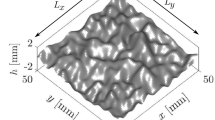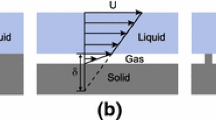Abstract
Drag reduction at topographically structured surfaces that contain a second immiscible fluid in their corrugations is evaluated. Based on a model for the effective slip length of a grooved surface, a threshold for the structured surface being superior to a flat surface with respect to drag reduction is derived for fluids of arbitrary viscosity filling the grooves and flowing over the surface. The specific magnitude of drag reduction is given exemplarily for pressure-driven pipe flow. Flow transverse to the grooves as well as flow longitudinal to open and closed grooves is considered. For typical surface geometry parameters, a flow rate enhancement by several tens of percent is predicted.








Similar content being viewed by others
References
Barthlott W, Neinhuis C (1997) Purity of the sacred lotus, or escape from contamination in biological surfaces. Planta 202(1):1–8
Basset A (1888) A treatise on hydrodynamics, vol 2. Cambridge University Press, Cambridge
Brennan JC, Fairhurst DJ, Morris RH, McHale G, Newton MI (2014) Investigation of the drag reducing effect of hydrophobized sand on cylinders. J Phys D Appl Phys 47(20):205–302
Busse A, Sandham ND, McHale G, Newton MI (2013) Change in drag, apparent slip and optimum air layer thickness for laminar flow over an idealised superhydrophobic surface. J Fluid Mech 727:488–508
Crowdy D (2010) Slip length for longitudinal shear flow over a dilute periodic mattress of protruding bubbles. Phys Fluids 22(12):121703
Daschiel G, Perić M, Jovanović J, Delgado A (2013) The holy grail of microfluidics: sub-laminar drag by layout of periodically embedded microgrooves. Microfluid Nanofluid 15(5):675–687
Davis AMJ, Lauga E (2009) Geometric transition in friction for flow over a bubble mattress. Phys Fluids 21(1):011701
Davis AMJ, Lauga E (2010) Hydrodynamic friction of fakir-like superhydrophobic surfaces. J Fluid Mech 661:402–411
Eijkel J (2007) Liquid slip in micro- and nanofluidics: recent research and its possible implications. Lab Chip 7(3):299–301
Gruncell BRK, Sandham ND, McHale G (2013) Simulations of laminar flow past a superhydrophobic sphere with drag reduction and separation delay. Phys Fluids 25(4):043–601
Hocking LM (1976) A moving fluid interface on a rough surface. J Fluid Mech 76(4):801–817
Lauga E, Stone HA (2003) Effective slip in pressure-driven stokes flow. J Fluid Mech 489:55–77
Lauga E, Brenner MP, Stone HA (2005) Microfluidics: the no-slip boundary condition. In: Foss J, Tropea C, Yarin A (eds) Handbook of experimental fluid dynamics. Springer, Berlin
Luchini P, Manzo F, Pozzi A (1991) Resistance of a grooved surface to parallel flow and cross-flow. J Fluid Mech 228:87–109
Navier M (1823) Mémoire sur les lois du mouvement des fluides. Mémoires de l’Académie royale des Sciences de l’Institut de France 6:389–440
Philip JR (1972) Integral properties of flows satisfying mixed no-slip and no-shear conditions. Z Angew Math Phys (ZAMP) 23(6):960–968
Pironneau O, Arumugam G (1989) On riblets in laminar flows. Control Bound Stab 125:51–65
Richardson S (1971) A model for the boundary condition of a porous material. Part 2. J Fluid Mech 49:327–336
Richardson S (1973) On the no-slip boundary condition. J Fluid Mech 59:707–719
Rothstein JP (2010) Slip on superhydrophobic surfaces. Ann Rev Fluid Mech 42(1):89–109
Schönecker C, Hardt S (2013) Longitudinal and transverse flow over a cavity containing a second immiscible fluid. J Fluid Mech 717:376–394
Schönecker C, Baier T, Hardt S (2014) Influence of the enclosed fluid on the flow over a microstructured surface in the Cassie state. J Fluid Mech 740:168–195
Solomon B, Khalil K, Varanasi K (2013) H7.00005: Lubricant-impregnated surfaces for drag reduction in viscous laminar flow. In: 66th Annual Meeting of the APS Division of Fluid Dynamics, Session H7: Microfluids: Interfaces and Wetting II, Pittsburgh, Pennsylvania, vol 58
Steinberger A, Cottin-Bizonne C, Kleimann P, Charlaix E (2007) High friction on a bubble mattress. Nat Mater 6:665–668
Wong TS, Kang SH, Tang SKY, Smythe EJ, Hatton BD, Grinthal A, Aizenberg J (2011) Bioinspired self-repairing slippery surfaces with pressure-stable omniphobicity. Nature 477(7365):443–447
Acknowledgments
The authors kindly acknowledge funding from the German Science Foundation (DFG) through the Excellence Cluster “Smart Interfaces” and the Graduate School of Excellence “Computational Engineering”.
Author information
Authors and Affiliations
Corresponding author
Rights and permissions
About this article
Cite this article
Schönecker, C., Hardt, S. Assessment of drag reduction at slippery, topographically structured surfaces. Microfluid Nanofluid 19, 199–207 (2015). https://doi.org/10.1007/s10404-015-1565-5
Received:
Accepted:
Published:
Issue Date:
DOI: https://doi.org/10.1007/s10404-015-1565-5




